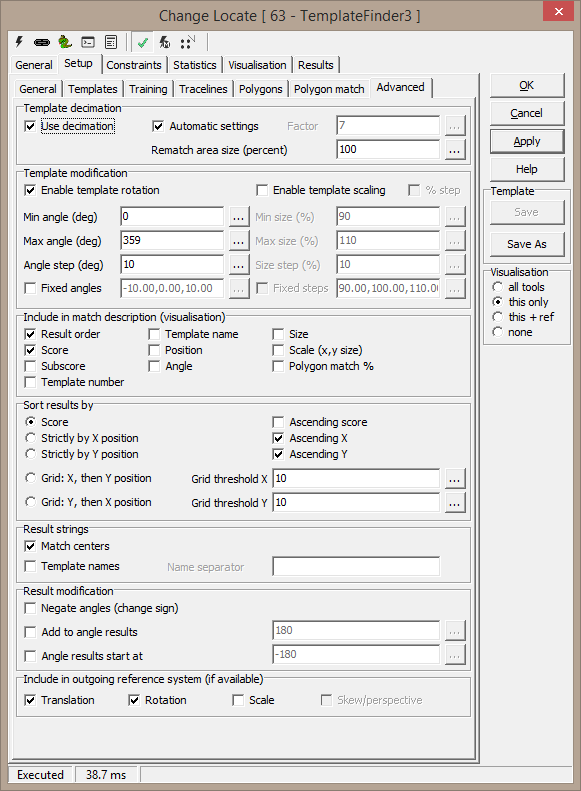Template
Decimation - When active the template and image is decimated before
matching. This speeds up the tool when the templates get big. The decimated
size of a template should be at least 10 by 10 pixels.
Note: Image decimation leads to lower score
values - a decimation factor of up to 5 or so will normally just speed up the template
matcher - higher values can degrade detection capabilities. Be aware - the
effect depends on your application and the images - it has to be
investigated in each case.
Automatic settings - Calculate the decimation
factor automatically based on the templates
The decimation will inevitably lead to inaccurate
positioning of the matches. A second, non-decimated rematch is always
performed in the vicinity of each candidate, improving accuracy and possibly
eliminating false matches.
Rematch area size (percent) - the size of the rematch area is set as a percentage of the
decimation factor. A low percentage speeds up the rematch, but matches may
be missed. 100% means an area of +/- Factor pixels horizontally and
vertically.
Template modification - use modified templates:
Include in match description - specify the
description visualisation string
-
Result order - see Sort results by
-
Score - see Score calculation
-
Subscore - Subimage score
-
Template number - numbered from 1
-
Template name - user defined template name
-
Position - x,y in result coordinates
-
Angle - in result coordinates
-
Size - percent of template size
-
Scale - percent of template size, split into x and
y results (may differ if polygon match is active)
-
Polygon match % - percent of polygon points that
matched
Sort results by
-
Score - calculated as per the score calculation
percentage
-
Strictly by X position - X position only
-
Strictly by Y position - Y position only
-
Grid: X, then Y position - cluster positions
into rows and columns, order as rows
-
Grid: Y, then X position - cluster positions
into rows and columns, order as columns
-
Ascending X - smallest value first
-
Ascending Y - smallest value first
-
Grid threshold X
-
Grid threshold Y - used to cluster
positions into rows and columns (in result coordinates)
Result strings
Result modification
-
Negate angles - change sign of all angle results
-
Add to angle results - fixed angle offset, all
angle results
-
Angle results start at - resolves angle ambiguity.
If set to -180, angle results are [-180,180); if set to 0, results are
in [0,360).
Include in outgoing reference system - the
outgoing reference system is a reference to the first match (defined with
Sort results by).
-
Translation - match position
-
Rotation - match rotation
-
Scale - match scale
-
Skew/perspective - complete transformation from the
polygon match
-
Individual template angle - outgoing reference
reflects template angle (Note: this setting is only available for
older profiles - for newer profiles this is always on)
